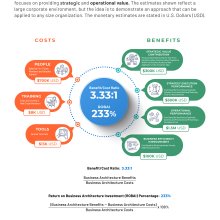In this installment of StraightTalk, we will focus on one of those burning questions: how do we calculate the return on investment (ROI) of a business architecture practice within an organization?
As a global discipline and community of practitioners, we’ve come a long, long way with business architecture. But we’re still on the journey, with work ahead to continue building understanding, adoption and practice. Business architecture success stories and demonstrable ROI are crucial for this.
In this StraightTalk post, we will explore a method for determining the ROI of a business architecture practice that you can put into use ASAP. The intention here is to provide a place to start and give you some ideas, but hopefully, inspire many more of your own.
Why is this important?
First, knowing the ROI of your business architecture practice will give your business architecture team visibility to and accountability for value delivered to the organization, right?
Second, communicating the ROI of your business architecture practice within your organization will help you to build buy-in and advocacy for the discipline internally. Communicating the ROI of your business architecture practice to others outside of your organization, such as by sharing with the business architecture community, will help us all to build understanding and advocacy for the discipline worldwide – which in turn strengthens us as individual business architecture practitioners and teams.
So, where do we start?
How about a definition. According to Investopedia, ROI is a performance measure used to evaluate the efficiency of an investment or compare the efficiency of a number of different investments. Furthermore, it states, that ROI is a popular metric because of its versatility and simplicity. Essentially, ROI can be used as a rudimentary gauge of an investment’s profitability.
So, ROI can give us a basic gauge for the profitability of an organization’s investment in business architecture. And, we need to look at two sides: business architecture costs and business architecture benefits. But first, how we frame business architecture ROI for an organization is extremely important.
Okay, how do we frame business architecture ROI for an organization?
It all starts with how the value proposition of business architecture has been defined for your organization. This is perhaps the most important thing a business architecture team needs to do as it will drive outcomes, measurement, decisions, focus, priorities and investments.
An organization’s intended business architecture value proposition will directly inform the metrics used to capture its benefits. For example, if the intended value for using business architecture in a particular organization is primarily focused on simplification, then metrics that reflect the amounts of reuse and cost savings realized would likely be useful.
Important: If your team has not already defined the value of business architecture to your organization, do not proceed further with ROI calculation, do not focus on your models and tools, do not pass Go, do not collect $200 until you have done so. More on starting a practice in Post No. 4.
What’s the formula?
This is the easy part. The hard part is actually obtaining the business architecture cost and benefit data, especially the benefit data.
The formula for Return on Investment (ROI) is:
ROI = (Current Value of Investment – Cost of Investment) / Cost of Investment
So, the formula for the Return on Business Architecture Investment (ROBAI) is:
ROBAI = (Business Architecture Benefits – Business Architecture Costs) / Business Architecture Costs
We can express ROI as a ratio or percentage.
You can also get fancy and calculate Net Present Value (NPV), which accounts for differences in the value of money over time due to inflation, or Breakeven Point, which defines the point when the business architecture benefits will have exceeded the costs.
How do we calculate business architecture costs?
This is the easy one. Business architecture costs are the summation of what your organization spends to create, maintain, use and govern its business architecture and supporting practice.
Here are some categories for consideration. (Or make up your own.)
- Team – This includes salary and/or contracting costs for those working in a business architecture role. It could also include those who play a direct role in supporting the business architecture team as well, such as a graphic designer.
- Training – This includes business architecture training and resource costs, such as training courses, certification fees, conferences, memberships to industry associations, access to research, books, etc.
- Tools – This includes costs for business architecture knowledgebase tools and any supporting tools such as those used for analytics, visualization or team collaboration.
How do we calculate business architecture benefits?
Business architecture benefits are the summation of the metrics you’ve chosen that best monetize your value proposition, as referenced above. (More on these metrics in Post No. 21.)
Here are some categories for consideration. (Or make up your own.)
- Strategic Value Contribution – This quantifies business architecture contribution to measures such as revenue or customer experience improvement. For example, business architects may identify or facilitate the identification of new sources of customer value or revenue with business model or value stream innovation.
- Strategy Execution Performance Improvement – This quantifies business architecture contribution specifically to improving end-to-end strategy execution, and may be reflected in measures such as cost or time reduction or avoidance. For example, business architects may identify or facilitate the identification of potentially redundant or improperly sequenced initiatives before they happen, or reduce the time necessary for defining requirements downstream due to the input of business architecture. (P.S. StraightTalk Posts No. 3 and No. 50 have you covered on the role of business architecture in strategy execution and No. 9 discusses a bit on how it is used to translate strategy.)
- Operational Performance Improvement – This quantifies business architecture contribution to any sort of efficiency or simplification efforts, and may also include preventing or reducing risk or compliance issues. This may be reflected in measures such as cost, time or risk reduction or avoidance. For example, business architects may identify or facilitate the identification of potentially redundant systems and processes, or head off a potential risk or compliance issue before it happens.
- Business Effectiveness Improvement – This quantifies business architecture contribution to the daily course of doing business and may be reflected in measures such as cost or time reduction. For example, the presence of a well-defined business architecture (minimally inclusive of a capability map, information map and value streams) can save time on an ongoing basis by providing the common vocabulary and mental model that enables effective communication and onboarding for both internal and external resources.
Why is it so hard to calculate business architecture benefits?
Measuring business architecture benefits and value can be a little bit of a challenge. For example:
- Some business architecture results are intangible, like when it helps to inform decisions or create clarity
- Business architecture can lead to the avoidance of negative results, like that misaligned investment that you didn’t make or like that compliance issue which didn’t happen
- Business architecture results can be hard to isolate because it is one team among many working together within the strategy execution ecosystem
- Business architecture results can create unwanted visibility for some people, so proceed with sensitivity when sharing results
So, just keep it simple and be at peace with the fact that you will often need to calculate your benefit numbers manually and in partnership with the people to whom you’ve provided them – just to make sure they agree on how you’ll be accounting for them.
Putting some numbers around business architecture benefits will help you reframe how people think about business architecture and its contribution to the organization. It’s well worth doing just for this fact alone. Otherwise, people tend to miss the bigger and longer-term picture and just focus on the fact that there were no business architects previously and now there are new salaries on the payroll. However, the bigger picture is that an investment in business architecture can be minuscule compared to the cost and time it can help save, the misaligned decisions or investments that didn’t happen, and the risks, issues or mistakes that were avoided.
Put it all together.
How about an example. See below for a simplified hypothetical illustration of the Return On Business Architecture Investment (ROBAI) that might be delivered by a dedicated, five-person business architecture team in its third year. The business architecture cost and benefit amounts are shown by category, resulting in a Business Architecture Benefit/Cost Ratio of 3.33:1 and a ROBAI of 233%.
The Fine Print: This is a pretty realistic example for a small but mighty business architecture team working in a large corporate environment, assuming they have had the right investment and positioning over time. One could get more precise in counting business architecture benefits, such as by calculating the time saved by everyone in the organization on an ongoing basis by having a common vocabulary and framework for onboarding. On the other hand, it could also take into account more precise business architecture costs such as the time dedicated by business people to build the business architecture. Perhaps the most important consideration is determining how you will account for costs and benefits within your defined reporting period. For example, will a new revenue idea be counted as an estimate when it is discovered, or as it is realized over months or years? The granularity of reporting should also be considered, such as if ROBAI will be calculated by initiative, by team member, by benefit category, or by the practice as a whole. You decide.
How should we communicate business architecture ROI?
Communicate your business architecture ROI to your business architecture leaders and stakeholders within the organization together with any other reporting you do on a regular basis, such as with your business architecture metrics (see Post No. 21) and success stories.
Remember that while numbers like your business architecture ROI are useful, they are only part of communicating business architecture value and success. It’s not just about the quantifiable numbers. The success stories, quotes and advocacy by others in the organization on your behalf are just as important and will speak to people on a different level.
A Charge To Us As Business Architects.
There’s good news and bad news.
The bad news is that there is almost no business architecture ROI data in the public domain. So, the good news is that you’re not missing anything. The good news is also that if you are a business architecture leader, practitioner or passionate advocate, you get to be a pioneer.
Therefore, stop looking for business architecture ROI data and start creating it and sharing it. Pivot your passion for modeling to proving. It’s never been more important than right now. We are a global community and to truly succeed, the only way to full maturity and formalization of the business architecture discipline is together.
As Mahatma Gandhi is often quoted, “Be the change that you wish to see in the world.”
More Good Stuff…
The Value of Business Architecture: New Mindset, New Results (S2E white paper): Just in case you haven’t read it, check out this overview of the value of business architecture and how it can be applied.
A Framework for Measuring ROI of Enterprise Architecture (David F. Rico): Big shout out to Mr. David Rico, whose unique and important work underpinned this post.
Business Architecture Case Studies (Business Architecture Guild®): Not necessarily ROI numbers, but you can find loads of business architecture case studies from previous Summits on the Public Resources page of the Guild website.
How Will You Measure Your Life? (TED Talk): An excellent TED Talk by Clay Christensen, Harvard Business School professor and innovation guru, on how we measure success in life against the progress we make in our careers. Good reflection here on what is truly important.

